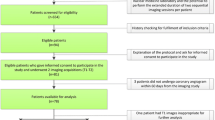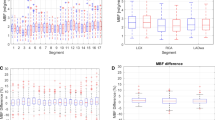Abstract
Purpose
Shortening scan time and/or reducing radiation dose at maintained image quality are the main issues of the current research in radionuclide myocardial perfusion imaging (MPI). We aimed to validate a new iterative reconstruction (IR) algorithm for SPECT MPI allowing shortened acquisition time (HALF time) while maintaining image quality vs. standard full time acquisition (FULL time).
Methods
In this study, 50 patients, referred for evaluation of known or suspected coronary artery disease by SPECT MPI using 99mTc-Tetrofosmin, underwent 1-day adenosine stress 300 MBq/rest 900 MBq protocol with standard (stress 15 min/rest 15 min FULL time) immediately followed by short emission scan (stress 9 min/rest 7 min HALF time) on a Ventri SPECT camera (GE Healthcare). FULL time scans were processed with IR, short scans were additionally processed with a recently developed software algorithm for HALF time emission scans. All reconstructions were subsequently analyzed using commercially available software (QPS/QGS, Cedars Medical Sinai) with/without X-ray based attenuation correction (AC). Uptake values (percent of maximum) were compared by regression and Bland-Altman (BA) analysis in a 20-segment model.
Results
HALF scans yielded a 96% readout and 100% clinical diagnosis concordance compared to FULL. Correlation for uptake in each segment (n = 1,000) was r = 0.87at stress (p < 0.001) and r = 0.89 at rest (p < 0.001) with respective BA limits of agreement of −11% to 10% and −12% to 11%. After AC similar correlation (r = 0.82, rest; r = 0.80, stress, both p < 0.001) and BA limits were found (−12% to 10%; −13% to 12%).
Conclusion
With the new IR algorithm, SPECT MPI can be acquired at half of the scan time without compromising image quality, resulting in an excellent agreement with FULL time scans regarding to uptake and clinical conclusion.


Similar content being viewed by others
References
Klocke FJ, Baird MG, Lorell BH, et al. ACC/AHA/ASNC guidelines for the clinical use of cardiac radionuclide imaging—executive summary: a report of the American College of Cardiology/American Heart Association Task Force on Practice Guidelines (ACC/AHA/ASNC Committee to Revise the 1995 Guidelines for the Clinical Use of Cardiac Radionuclide Imaging). J Am Coll Cardiol. 2003;42:1318–33.
Taillefer R, Primeau M, Costi P, Lambert R, Leveille J, Latour Y. Technetium-99 m-sestamibi myocardial perfusion imaging in detection of coronary artery disease: comparison between initial (1-hour) and delayed (3-hour) postexercise images. J Nucl Med. 1991;32:1961–5.
Borges-Neto S, Pagnanelli RA, Shaw LK, et al. Clinical results of a novel wide beam reconstruction method for shortening scan time of Tc-99 m cardiac SPECT perfusion studies. J Nucl Cardiol. 2007;14:555–65.
DePuey EG, Nichols KJ, Slowikowski JS, et al. Fast stress and rest acquisitions for technetium-99 m-sestamibi separate-day SPECT. J Nucl Med. 1995;36:569–74.
Ali I, Ruddy TD, Almgrahi A, Anstett FG, Wells RG. Half-Time SPECT myocardial perfusion imaging with attenuation correction. J Nucl Med. 2009;50:554–62.
Cerqueira MD, Verani MS, Schwaiger M, Heo J, Iskandrian AS. Safety profile of adenosine stress perfusion imaging: results from the Adenoscan Multicenter Trial Registry. J Am Coll Cardiol. 1994;23:384–9.
Hansen CL, Goldstein RA, Akinboboye OO, et al. Myocardial perfusion and function: single photon emission computed tomography. J Nucl Cardiol. 2007;14:e39–60.
Hesse B, Tagil K, Cuocolo A, et al. EANM/ESC procedural guidelines for myocardial perfusion imaging in nuclear cardiology. Eur J Nucl Med Mol Imaging. 2005;32:855–97.
Schepis T, Gaemperli O, Koepfli P, et al. Use of coronary calcium score scans from stand-alone multislice computed tomography for attenuation correction of myocardial perfusion SPECT. Eur J Nucl Med Mol Imaging. 2007;34:11–9.
Germano G, Kavanagh PB, Waechter P, et al. A new algorithm for the quantitation of myocardial perfusion SPECT. I: technical principles and reproducibility. J Nucl Med. 2000;41:712–9.
Berman DS, Kiat H, Friedman JD, et al. Separate acquisition rest thallium-201/stress technetium-99 m sestamibi dual-isotope myocardial perfusion single-photon emission computed tomography: a clinical validation study. J Am Coll Cardiol. 1993;22:1455–64.
Cerqueira MD, Weissman NJ, Dilsizian V, et al. Standardized myocardial segmentation and nomenclature for tomographic imaging of the heart: a statement for healthcare professionals from the Cardiac Imaging Committee of the Council on Clinical Cardiology of the American Heart Association. Circulation. 2002;105:539–42.
Sharir T, Germano G, Waechter PB, et al. A new algorithm for the quantitation of myocardial perfusion SPECT. II: validation and diagnostic yield. J Nucl Med. 2000;41:720–7.
Bland JM, Altman DG. Statistical methods for assessing agreement between two methods of clinical measurement. Lancet. 1986;1:307–10.
Daou D, Pointurier I, Coaguila C, et al. Performance of OSEM and depth-dependent resolution recovery algorithms for the evaluation of global left ventricular function in 201Tl gated myocardial perfusion SPECT. J Nucl Med. 2003;44:155–62.
DePuey EG, Gadiraju R, Clark J, Thompson L, Anstett F, Shwartz SC. Ordered subset expectation maximization and wide beam reconstruction "half-time" gated myocardial perfusion SPECT functional imaging: a comparison to "full-time" filtered backprojection. J Nucl Cardiol. 2008;15:547–63.
Bateman TM, Heller GV, McGhie AI. Application of simultaneous Gd-153 line source attenuation correction to half-time SPECT acquisitions: multi-center clinical evaluation. Paper presented at: ASNC 2007 meeting; September 6–9; San Diego, California.
Kritzman JN, Cahill JM, Ficaro EP, Corbett JR. Quantitative comparison of standard and reduced acquisition time attenuation corrected and non-corrected myocardial perfusion images: a phantom study utilizing a 3D iterative reconstruction [abstract]. J Nucl Cardiol. 2007;14(suppl 1):S107–8.
Author information
Authors and Affiliations
Corresponding author
Rights and permissions
About this article
Cite this article
Valenta, I., Treyer, V., Husmann, L. et al. New reconstruction algorithm allows shortened acquisition time for myocardial perfusion SPECT. Eur J Nucl Med Mol Imaging 37, 750–757 (2010). https://doi.org/10.1007/s00259-009-1300-0
Received:
Accepted:
Published:
Issue Date:
DOI: https://doi.org/10.1007/s00259-009-1300-0




